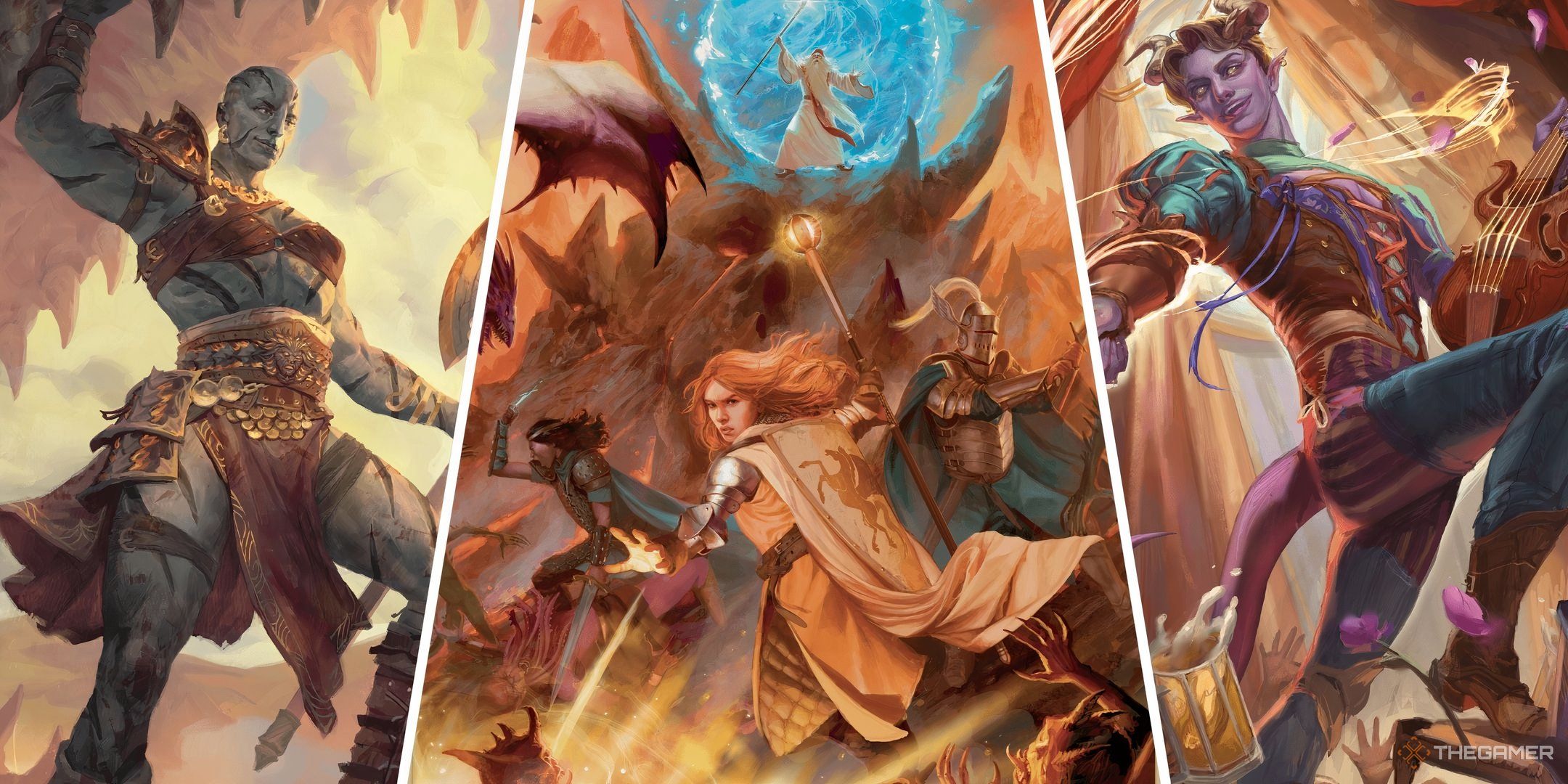Summary
- Sixth-level spells in D&D offer a variety of buffs, control, and utility options beyond pure damage spells.
- The ten most useful sixth level spells include Blade Barrier, True Seeing, and Contingency in the D&D world.
- Spells like Planar Ally, Word of Recall, and Tenser’s Transformation offer unique tactical advantages for players.
Sixth-level spells are probably the favorite for many Dungeons & Dragons players that prefer buff, walls, and control spells over damaging spells. While there are certainly damage-dealing spells in sixth level, this spell level is filled with excellent choices for those players that would rather control an enemy or cast buff spells versus overwhelming them with damage-dealers.

Related
Dungeons & Dragons: The 18 Most Useful Second-Level Spells, Ranked
Even as a second-level player in Dungeons & Dragons you have quite a lot of power, you just need to know how to use it with these powerful spells.
The majority of the spells listed are from Fifth Edition (5e). There are a couple of exceptions, but these two entries will have the spells’ details and in which books they can be found. Here are the ten most useful sixth level spells in D&D – ranked.
Updated on December 21, 2024, by Alfredo Robelo: The more a spellcaster levels up, the more fearsome they get, and that’s easily seen by these terrifying sixth-level spells. We’ve updated this article to include a few new toys from the 2024 Player’s Handbook, as well as bringing it up to date with current standards.
18
Blade Barrier
|
School |
Class |
Description |
|---|---|---|
|
Evocation |
Cleric |
Create a wall of sharp, moving blades. |
While wizards tend to be the masters of terrain manipulation, the other Dungeons & Dragons casters don’t fall too far behind. Blade Barrier gives clerics a way to mold the battlefield to benefit them, creating an impressive wall that can be up to 100 feet long, damaging foes that may wish to pass through it.
Granted, your allies would suffer the damage as well, so be sure to use this spell only when creatures are chasing you. Not only do enemies suffer 6D10 force damage when passing through the wall, the barrier itself serves as cover, making it ideal against foes that are slow and relegated to the melee range.
17
Tasha’s Bubbling Cauldron
|
School |
Class |
Description |
|---|---|---|
|
Conjuration |
Warlock, Wizard |
Summon a cauldron that can copy potion effects. |
Tasha’s Bubbling Cauldron is a new spell added to the 2024 Player’s Handbook, allowing you to summon a cauldron and have it produce various potions depending on your ability modifier. The potions disappear if you cast this spell again, but otherwise you get to keep them, meaning that this is one of the best spells to cast during downtime.
There are several enticing options to choose from when it comes to creating potions, particularly since you don’t need to have the potion in hand already. You can give your entire party the strength of a giant, resistance to fire, or have them benefit from Freedom of Movement without needing to concentrate on any single spell.
16
Eyebite
|
School |
Class |
Description |
|---|---|---|
|
Necromancy |
Bard, Sorcerer, Warlock, Wizard |
Force a creature to sleep, be frightened or be poisoned. |
Eyebite tends to be looked over when compared to other spells, particularly due to the action economy revolving around combat. The thing is, the role of Eyebite isn’t the same as other spells that target several creatures at once; the point of the spell is to incapacitate one creature, either a priority target in combat or during a social encounter, where combat is the last thing you want to do.
Once you cast the spell, you’ll need to concentrate for a minute, but you are able to target more than one creature every turn. If your target fails a saving throw, you can force them to either fall asleep, run away in fear, or suffer from the poisoned condition, making them roll attacks with disadvantage.
15
Heroes’ Feast
|
School |
Class |
Description |
|---|---|---|
|
Conjuration |
Bard, Cleric, Druid |
Give your party several benefits for 24 hours. |
Heroes’ Feast is a spell that can be the deciding factor between victory and defeat. Unlike a strategically placed fireball that is cast in the midst of battle, though, Heroes’ Feast must be cast well in advance of a fight. This means it is really only useful when you know for sure a fight is looming near.
This spell takes ten minutes to cast and one hour to consume the feast it provides, but affects up to 12 creatures. The feast cures all diseases and poisons and confers immunity to poison and being frightened. Affected creatures also gain an additional 2d10 hit points added to their maximum. These effects last for 24 hours.
14
True Seeing
|
School |
Class |
Description |
|---|---|---|
|
Divination |
Bard, Cleric, Sorcerer, Warlock, Wizard |
Gain Truesight. |
In a fantasy setting full of illusions, shape-changers, and trapped dungeons it is almost a necessity to be able to see things for what they truly are. Casting True Seeing gives the caster true sight. This allows them to see anything that is hidden or altered via magic or some other means, whether it is a living being or an inanimate object.

Related
Dungeons & Dragons: The Most Useful First-Level Spells, Ranked
There are a lot of different classes in Dungeons & Dragons that use magic, while there are many spells, these are the best first level ones.
True Seeing even also allows the caster to see into the Ethereal Plane. The spell has a range of 120′ and has a very long duration of one hour. Such a long duration is incredibly useful because the caster will probably have the use of true seeing until the party needs to rest again.
13
Trollish Fortitude
|
School |
Class |
Description |
|---|---|---|
|
Necromancy |
Wizard |
Gain the regenerative properties of a Troll. |
This spell is from the third edition of D&D.
Recipients of this spell regenerate three hit points per round. Any persistent loss of hit points that carry over from round-to-round, like damage from a wounding weapon, are ignored. Any dismembered limbs, including the character’s head, can be reattached by simply holding them in their proper location for one round.
This spell can’t protect against (or regenerate) poisons and diseases that don’t deal damage, or fire and acid damage, and it can’t restore a loss to maximum hit points. The duration is one round a level and can only affect the caster. The material component is a piece of dried troll heart, ground into a powder. This spell can be found in Player Options: Skills and Powers and the Wizard’s Spell Compendium.
12
Mass Suggestion
|
School |
Class |
Description |
|---|---|---|
|
Enchantment |
Bard, Sorcerer, Wizard |
Charm several creatures and suggest a course of action. |
This is an excellent spell for those times when you need a distraction, are outnumbered, or are running an evil character that enjoys ordering people to do your bidding whether they want to or not. Mass Suggestion affects up to 12 creatures within sight and earshot of the caster.
Once affected, these creatures can be given simple commands – no more than a sentence or two. One great aspect of this spell is that it has a duration of 24 hours, and this can be significantly increased by memorizing it at a higher spell level.
11
Sunbeam
|
School |
Class |
Description |
|---|---|---|
|
Evocation |
Cleric, Druid, Sorcerer, Wizard |
Create a bright line of radiant damage. |
Sunbeam is one of those super-flashy (in this case literally) spells that essentially turns the caster into a superhero for one minute. Casting Sunbeam allows the caster to project beams of light 5’ wide and 60’ long from the palm of their hand. This can be done every time the caster has an action available until the end of the spell’s duration (one minute).
These sunbeams deal 6d8 points of damage to any creature in their path. The caster’s palm also emits light in a 30’ radius. This light is considered sunlight, so this spell is quite useful against undead, which are some of the most challenging creatures to fight in Dungeons & Dragons.
10
Contingency
|
School |
Class |
Description |
|---|---|---|
|
Abjuration |
Wizard |
Prepare a spell to be cast automatically later. |
This spell allows the caster to have one spell set to take effect immediately when a set condition is met. The usefulness of this should be fairly self-evident. A player could set a spell that allows for water-breathing if their character is ever submerged. Another great set-up is to have an invisibility spell take effect if the character is reduced to less than 50 percent of their maximum hit points.
There aren’t many restrictions to the Contingency spell either; the two major restrictions are the spell can only affect the caster and the contingent spell must be a fifth level or lower spell with a casting time of one action. The contingent spell does not have to be an arcane spell; the caster can use memorized divine spells as well.
9
Globe Of Invulnerability
|
School |
Class |
Description |
|---|---|---|
|
Abjuration |
Sorcerer, Wizard |
Create an area where no damage can be taken. |
When playing with a DM who enjoys using spells against the players, this is one of the more useful spells a character can have memorized. Globe of Invulnerability creates a shimmering barrier 10’ in radius around the caster. This barrier prevents spells of fifth level or lower from penetrating. This is effective against spells that have been memorized at a higher spell slot – like a Fireball occupying a ninth-level spell slot.

Related
Dungeons & Dragons: 10 Tips For Better Character Creation
Don’t fall back on the mundane; make better characters for your next campaign.
Globe of Invulnerability is also a scalable spell, increasing the protection by a spell level for every spell slot it occupies above sixth.
8
Chain Lightning
|
School |
Class |
Description |
|---|---|---|
|
Evocation |
Sorcerer, Wizard |
Hit several targets with lightning. |
This is an extremely effective spell for damaging a group of opponents. The caster can launch a Lightning Bolt at a target, which need not be alive; after striking the target the Lightning Bolt branches out to up to three additional targets. The additional targets must be within 30’ of the first being/object to be struck. Each affected being takes 10d8 points of damage; a passed Dexterity saving throw will reduce the damage by half.
A being or object cannot be struck twice by chain lightning though. This spell is scalable; each spell slot used to memorize it above sixth allows the spell to strike an additional target.
7
Tenser’s Transformation
|
School |
Class |
Description |
|---|---|---|
|
Transmutation |
Wizard |
Gain offensive buffs on par with most melee classes. |
Using this spell allows a wizard to engage in melee as well as a fighter. A multiclass fighter/wizard casting this spell becomes a truly terrifying force on the battlefield. First, this spell grants the caster an additional 50 hit points for the spell’s duration. All attacks made with simple or martial weapons are made with an advantage and deal an extra 2d10 points of force damage.
The caster also gains proficiency with all weapons, armor, shields, as well as Constitution and Strength saving throws. This spell also grants an extra attack unless the character already receives an extra attack per round. The only drawback is that after the spell’s duration expires, the caster must make a Constitution saving throw or suffer from one level of exhaustion.
6
Planar Ally
|
School |
Class |
Description |
|---|---|---|
|
Conjuration |
Cleric |
Summon an otherwordly entity. |
This powerful spell can summon a celestial servant, an elemental, or a fiend to aid the caster. This creature must unfortunately be bargained with in order to secure its help. Paying for this help isn’t cheap either; the suggested price is 100 gold pieces per minute, or 10,000 gold pieces a day. Tasks that are aligned with the summoned creature’s alignment are often performed for free. This means summoning a planetar to help fight a demon will probably not cost the caster anything.
The task doesn’t have to include fighting – the adaptability of this spell is why it’s one of the best sixth-level spells. These planar allies could be used to help solve a riddle that is stumping the party, retrieve an item the party can’t access, and for information about a person, creature, or location.
5
Disintegrate
|
School |
Class |
Description |
|---|---|---|
|
Transmutation |
Sorcerer, Wizard |
Cast a damaging spell that destroys most objects. |
Disintegrate delivers significant damage, but that is not the only useful application of this spell. A being targeted with this spell takes 10d6 + 40 points of damage if they fail a Dexterity saving throw; a passed saving throw allows the target to escape the effects entirely.
If the target is reduced to zero hit points or less, they, along with all worn and carried items, are disintegrated – only a pile of gray dust remains. This spell can also be used to destroy a large-sized or smaller object or magical creation (like a wall of force) automatically. This spell can be used in this manner to create a passage through a solid barrier no more than 10’ thick.
4
Heal
|
School |
Class |
Description |
|---|---|---|
|
Abjuration |
Cleric, Druid |
Heal an ally and restore negative effects. |
Even though this spell isn’t as effective as it was in previous editions, it is still one of the best healing spells. Heal restores up to 70 hit points to the target, as well as any curing any disease, deafness, and blindness effects on the recipient. Previous editions had this spell fully restore the target’s hit points, but required the caster to touch the recipient.

Related
Dungeons & Dragons: The 21 Most Useful Fourth-Level Spells, Ranked
There are a bunch of great 4th level spells in D&D, but these are the most useful.
Like most healing spells in 5e, Heal has no effect against undead; in previous editions of D&D, this spell was devastating to even the most powerful of undead creatures. Heal is scalable, adding ten hit points to the amount healed for every spell slot used above Sixth level.
3
Entropy Shield
|
School |
Class |
Description |
|---|---|---|
|
Abjuration |
Cleric |
Create a protective shield. |
This spell was not included in 5e, which is a shame considering how useful it was for clerics that sought out close-combat situations (or found themselves in them frequently). For the duration of this spell, the caster is surrounded by a magical field of chaos energy that increases the caster’s armor class by two. This barrier causes all melee attacks to miss 50 percent of the time; this is rolled before the attack roll.
Additionally, all fired and hurled distance attacks automatically miss; this includes spells such as Acid Arrow and Magic Missile. Any offensive spell that creates material or energy, like a Fireball, has a 50 percent chance of being negated (for the caster only). Only spells that don’t create something (like Charm Person), can bypass the Entropy Shield. This spell has a duration of one round per caster level.
This is the Second Edition version of Entropy Shield, and can be found in Player’s Options: Spells and Magic and the Priest’s Spell Compendium.
2
Investiture Of Wind
|
School |
Class |
Description |
|---|---|---|
|
Transmutation |
Druid, Sorcerer, Warlock, Wizard |
Gain flight speed and push enemies away. |
This is a powerful spell with many useful effects for the caster. First, and perhaps most important, the caster has the ability to fly at a movement rate of 60. This spell also causes any missile attacks directed at the caster to be at a disadvantage. So the caster can remove themself from melee and have a certain amount of protection from ranged attacks.
Lastly, the caster can cause a 15’ cube-sized area to be buffeted with strong winds. Those caught in this area suffer 2d10 bludgeoning damage; however, a passed constitution saving throw reduces the damage by half. These buffeting winds also force large-sized or smaller creatures away from the center of the 15’ cube area.
1
Word Of Recall
|
School |
Class |
Description |
|---|---|---|
|
Conjuration |
Cleric |
Transport yourself and your party to a known sanctuary. |
Word of Recall is an often overlooked sixth-level spell. The reasons for this are many; for the most part, it’s because it’s not a flashy spell that devastates an enemy’s ranks. This spell is the opposite of a spell that helps your party win a fight – this is a spell that protects you from losing.
Think of Word of Recall as an insurance policy for the party. The caster must initially cast this spell in a sanctuary that is sacred to their deity. After this, instantaneously and at any time, the caster can teleport up to six people (including the caster) to the prepared location. This spell is basically a quicksave.































Leave a Reply